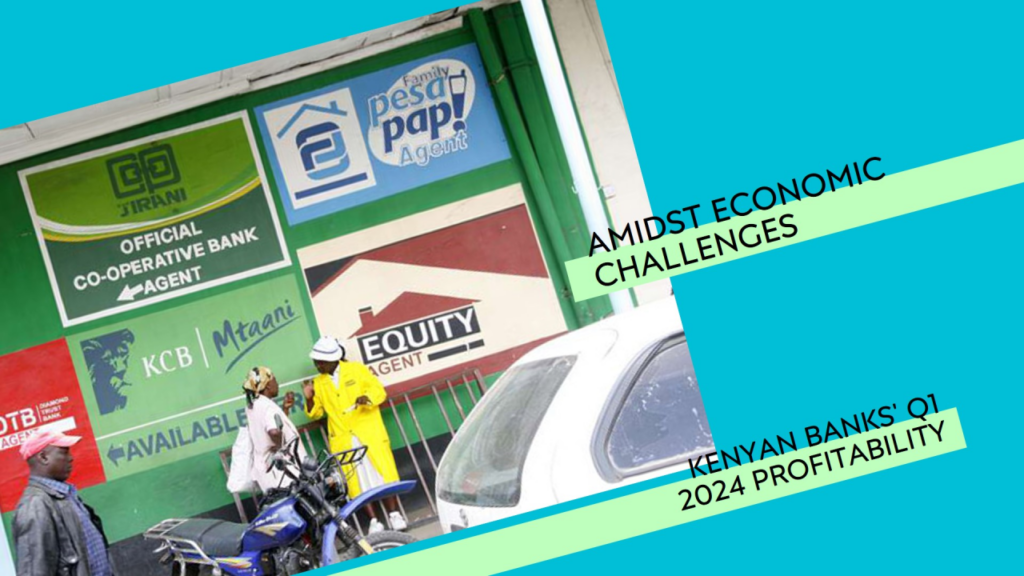
The year 2024 has been a paradox for Kenya’s economy. While many Kenyans faced economic difficulties—including high inflation, rising cost of living, and reduced business profitability—the banking sector reported record-breaking profits. Major banks like KCB Group, Equity Bank, and Co-operative Bank of Kenya have all seen substantial earnings growth. This raises a crucial question: How are banks thriving while the general population struggles? This in-depth article examines the factors behind Kenyan banks’ profitability in 2024, the economic backdrop, and what it means for ordinary citizens.
Economic Landscape in 2024
Kenya’s Sluggish Economic Growth
Kenya’s economy has faced several setbacks in 2024. The World Bank revised the country’s GDP growth forecast to 4.7%, down from an earlier estimate of 5.0%. This reduction is attributed to:
- Fiscal Challenges: The government has struggled with high debt levels, leading to increased borrowing and higher interest rates.
- Inflationary Pressures: Food and energy prices have remained high, affecting household purchasing power.
- Unfavorable Weather Conditions: Flooding in early 2024 disrupted agriculture, leading to lower yields and higher food prices.
- Political Protests: Anti-government demonstrations slowed business activity in key sectors such as retail and transportation.
Despite these challenges, banks have continued to generate massive profits.
Kenyan Banks’ Record Profits in 2024
Major Banks’ Financial Performance
Several leading banks have reported impressive profit growth:
- KCB Group
- Reported a pre-tax profit of KSh57.43 billion ($445 million) for the first nine months of 2024.
- This marked a 41.5% increase from KSh40.59 billion in the same period of 2023.
- The growth was driven by a 24% rise in net interest income, thanks to improved lending and better yields.
- Co-operative Bank of Kenya
- Announced a pre-tax profit of KSh26.8 billion for Q3 2024, up 8.5% from KSh24.7 billion in Q3 2023.
- National Bank of Kenya (NBK)
- Reported a 142% increase in after-tax profits, reaching KSh1.2 billion for Q3 2024.
How Are Banks Profiting Despite Economic Struggles?
Kenyan banks have adopted several strategies to maintain and even grow their profits:
- Investing Heavily in Government Securities
- Banks prefer lending to the government through Treasury Bills and Bonds, which offer high returns with minimal risk.
- The government, facing fiscal pressure, has offered attractive interest rates to raise funds.
- High Lending Rates
- Despite economic challenges, banks have continued to charge high-interest rates on loans, making lending highly profitable.
- The Central Bank of Kenya (CBK) reduced its benchmark interest rate by 75 basis points to 11.25% in December 2024, but banks have kept their lending rates relatively high.
- Growth in Digital and Mobile Banking
- Platforms like M-Pesa, Fuliza, and KCB Mobi Loan have increased banking revenues through transaction fees and interest on digital loans.
- Diversification of Revenue Streams
- Beyond traditional lending, banks have expanded into insurance, investment banking, and fintech partnerships, further boosting profits.
Implications for Ordinary Kenyans
While banks are thriving, the average Kenyan faces several financial challenges:
1. High Cost of Borrowing
- Despite the CBK lowering the benchmark rate, personal and business loans remain expensive.
- Many small businesses struggle to access affordable credit, stalling expansion and job creation.
2. Declining Purchasing Power
- Inflation continues to erode real incomes, making it harder for Kenyans to save or invest.
- The cost of essential goods and services, including food and transport, has remained high.
3. Low Returns on Savings
- Many savings accounts offer low interest, leading to negative real returns when adjusted for inflation.
- Banks benefit from these deposits by lending them at higher rates while paying minimal interest to depositors.
How Kenyans Can Navigate This Economic Landscape
To cope with these challenges, individuals and businesses must adopt smart financial strategies:
1. Be Strategic About Borrowing
- Avoid unnecessary loans: Only borrow for investments that can generate returns.
- Compare loan terms: Check interest rates and fees before taking a loan.
- Explore alternative lenders: SACCOs and microfinance institutions often provide lower-interest loans than banks.
2. Optimize Savings and Investments
- Money Market Funds: Offer higher returns than regular savings accounts.
- SACCO Deposits: Provide better interest rates and dividend payments.
- Government Bonds: Retail investors can benefit from stable, long-term returns.
3. Build an Emergency Fund
- Setting aside 3-6 months’ worth of expenses can cushion against financial shocks.
- Keeping money in an easily accessible yet interest-earning account is advisable.
4. Increase Financial Literacy
- Attend financial literacy programs to learn better money management skills.
- Stay updated on economic trends and investment opportunities.
The Future of Kenya’s Banking Sector
1. Increased Regulation?
- The government may introduce tighter regulations to ensure banks do not exploit high lending rates at the expense of borrowers.
2. Shift to Digital Banking
- Expect more fintech innovations as banks compete with mobile lenders.
3. Expansion into Regional Markets
- Kenyan banks will likely expand into East and Central Africa to tap into new markets.
Read: KCB Group Acquires 75% Stake in Riverbank Solutions
Conclusion
Kenyan banks have posted record profits in 2024, despite economic struggles facing ordinary citizens. While financial institutions benefit from government securities, high lending rates, and digital banking, many Kenyans struggle with inflation, high borrowing costs, and low savings returns.
To navigate these challenges, Kenyans must adopt smart borrowing, savings, and investment strategies. Additionally, financial literacy remains a key tool in ensuring long-term financial security.
The bottom line? While banks continue to profit, individuals must proactively manage their finances to thrive in an uncertain economic climate.





